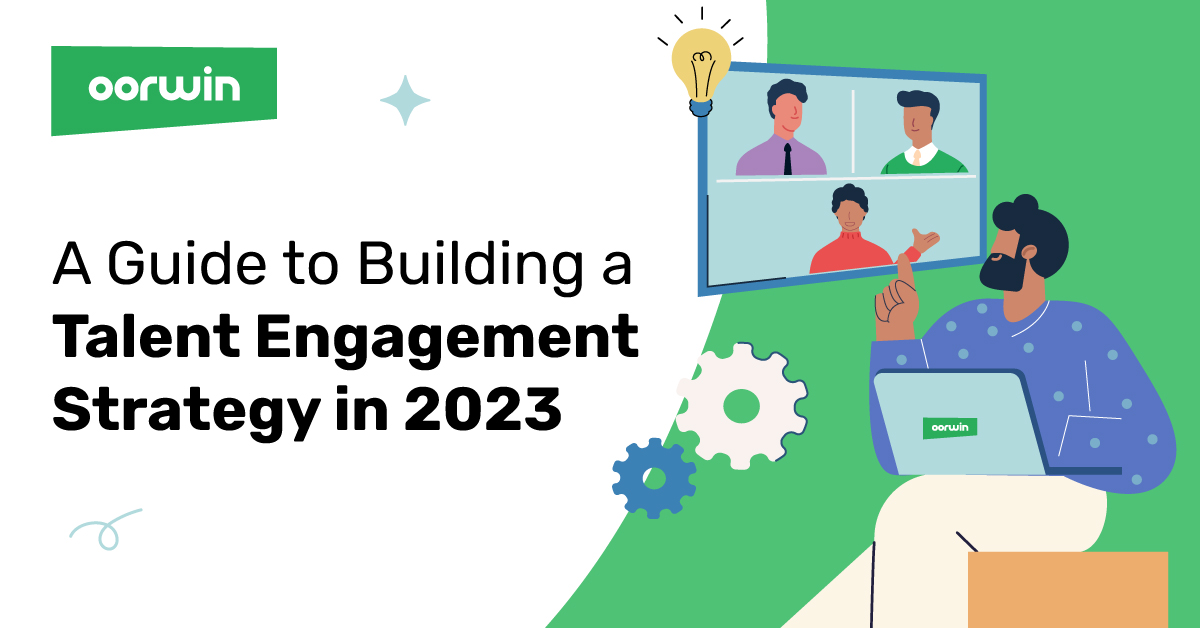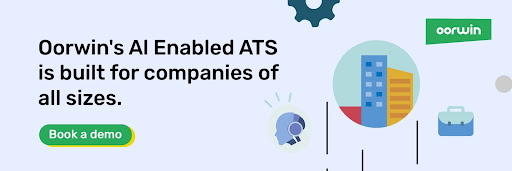A Guide to Building Talent Engagement Strategies in 2024
Oorwin
8min read / 30 Nov 2022

Related Articles
Innovative Employee Engagement Strategies: Your 2024 Play Book
Effective employee engagement is vital for any company looking to succeed. It’s focused on attracting the right employees and keeping them excited about the company’s goals. As we step into 2024, updating these strategies is vital, especially with AI shaping how we hire and engage. They’re essential for maintaining a sense of unity and purpose, especially in a world where remote work is increasingly common.
What is Employee Engagement Strategy?
A Employee Engagement Strategy focuses on attracting, retaining, and nurturing skilled employees, vital in today’s competitive job market. It starts with developing an appealing employer brand and employing targeted recruitment strategies to attract top talent, offering competitive packages and promising career paths.
The strategy extends to onboarding and integration, ensuring new hires smoothly assimilate into the company culture and clearly understand their roles. This approach fosters a positive work environment, encouraging long-term commitment and professional growth among employees.
The Importance of Employee Engagement in Today’s Workplace
Talent engagement strategies are vital in today’s work environment. They not only create a better workplace but also drive the company’s success. Engaged, talented employees mean a productive, innovative, and loyal workforce, directly impacting the bottom line.
1.Strengthening Bonds: Engagement reduces burnout and increases satisfaction, according to McKinsey’s findings.
2.Cultivating Culture: Aligning engagement with company values ensures everyone feels valued and contributes.
3.Boosting Performance: High engagement leads to greater productivity and team cohesion.
4.Elevating Motivation: Effective strategies increase employee commitment and enthusiasm for new challenges.
5.Fostering Innovation: Engagement encourages creativity, leading to innovative workplace solutions.
6.Enhancing Customer Experience: Engaged employees provide better service, improving customer satisfaction.
8 Effective Employee Engagement Strategies in 2024
To solve employee engagement issues, companies should really focus on their employees first. Many are losing their top talent because there’s not enough clear info about career growth. It’s important to show employees a clear path for their careers, one that fits their skills and dreams. Also, using AI can make managing talent easier. AI can look at employee data to figure out what they need, recommend training, and help make career plans that really fit each person.
1. Begin With a Survey
Starting with a detailed survey about employee engagement is a smart move. It gives you the real picture of what’s going well and what areas need some tweaking.
Listening to your team’s feedback through these surveys really shows you care about their opinions. It’s a key part of making your engagement strategies better.
For the best, most honest feedback, keep the surveys anonymous. This encourages your team to share their true thoughts comfortably, which is super helpful for you.
2. Define Your Personas
For a company, it is essential to understand the kinds of personas for its job profiles. These personas are not just simple demographic information but in-depth stories the company can tell about the people who work at their organization.
Understanding the education levels and background of the audience and their preferences can help show what to highlight in your job postings and which channels to use to reach out to the audience.
3. Upskilling Strategies
Upskilling means teaching employees to be better at the skills they already have. It’s like giving them a boost in what they know, so they can do their jobs better and feel more secure about their work. Companies that invest in upskilling show their employees that they care about helping them grow in their careers. This makes employees feel more satisfied and loyal. It also keeps the company competitive with a skilled workforce. Some upskilling strategies that aid in employee engagement include:
Regular Training Workshops: Offering workshops or training sessions regularly helps keep skills fresh and relevant.
Online Learning Platforms: Providing access to online courses allows employees to learn at their own pace and choose topics they’re interested in.
Mentorship Programs: Pairing employees with mentors gives them a chance to learn from experienced colleagues and gain new perspectives.
Skill Assessments: Regular assessments can help identify areas where employees might need more training or support.
4. Cross-skilling
Cross-skilling is all about teaching employees new skills that are useful in different parts of the business. This makes it easy for them to work in various teams or departments. It’s a smart way to have a workforce that can adapt and change when needed. Cross-skilling gets employees ready for different jobs in the company and keeps them learning new things. It fills in any skill gaps and gives employees more career options. Adding cross-skilling to your employee engagement strategy helps keep employees interested and eager to learn, which is really important for keeping them happy and committed to their jobs and the company.
5. Lateral moves
Allowing lateral moves means employees can change to a new role without changing their level or pay. It’s a chance for them to mix things up, learn different skills, and maybe even improve their work-life balance. This can really help keep them motivated and interested in their jobs. For employees, it’s a way to experience new challenges and see things from a different angle, without the extra pressure of a higher position. And for the company, it’s beneficial because it encourages the sharing of ideas and skills between departments, leading to a more collaborative and well-rounded workplace.
6. Leveraging Generative AI for Employee Engagement
Technology, especially generative AI, is changing how companies engage with their employees. These AI tools are really helpful because they provide personalized information and predictions. This means companies can understand their employees better and make plans that really fit what each person needs and likes. For example, AI can be used in applicant tracking systems (ATS) or CRM tools to help companies find the right candidates more efficiently. It can sort through resumes, match skills with job requirements, and even predict which candidates might fit well with the company’s culture. By using AI, companies can spot trends among employees, see problems before they happen, and create a more effective and quick-responding way of managing their people.
7. Foster Employee Innovation
Encourage your team to share their ideas and take part in shaping projects and initiatives. By promoting innovation and allowing them to experiment, you’re creating an environment where creativity thrives. This kind of atmosphere not only sparks innovation but also boosts employee happiness and keeps them around longer.
8. Focus on Employee Well-being
Integrating well-being into the core of employee engagement and employee retention strategies is crucial. This includes mental health support, flexible working arrangements, and initiatives that promote work-life balance. Focusing on well-being is essential for attracting and retaining talent in the modern workplace.
5 Keys to Employee Engagement
Employee Engagement Key 1: Define Talent
Your company must precisely define “talent” beyond labels for successful employee engagement. Document the specific attributes you seek in potential hires for roles like “leadership,” “communicator,” and “team player.” Involving various leaders will solidify your understanding and aid talent recognition during interviews.
Employee Engagement Key 2: Building a Strong Employer Brand
Create a strong employer brand that showcases your company as an appealing workplace. Ensure that everyone in the organization understands and recognizes its strength. A robust employer brand is rooted in a positive company culture, fair treatment of employees, attractive benefits and perks, and a conducive work environment. You can easily attract talented candidates by paying attention to what currently works for your employees and addressing any issues.
Employee Engagement Key 3: Be Efficient in Leading People
Prioritize investing time in leading and managing your employees. Research shows that employees’ decision to stay or leave a job is often influenced by their relationship with their manager. Beyond monetary incentives and career growth opportunities, a manager who genuinely leads dedicates time to communicate with their team, actively listens to their concerns, sets clear expectations, and provides feedback and recognition.
Employee Engagement Key 4: Being Conversational
Encourage a culture of respectful and collaborative conversations. Foster open dialogue where employees comfortably express ideas and concerns. A manager’s attentive and empathetic listening is valuable. Respectful exchanges build trust, strengthen relationships, and prioritize discussions. Create an environment where individuals feel heard and valued.
Employee Engagement Key 5: Develop Resilience
Resilience is a crucial trait in the face of challenges and uncertainties. Encourage and reinforce resilience within your workforce. Offer training programs and processes that continuously build and enhance employees’ skills, update their knowledge, and maintain high efficiency. A resilient force is better equipped to handle crises and attracts talented individuals seeking opportunities for growth and development.
Streamline Your Employee Engagement with Oorwin’s AI Technology
Oorwin’s platform, powered by AI, makes it easy to keep talent engaged. It lets recruiters quickly find candidates from a list of profiles and talk to them using text, emails, or meetings. The best part? Much of the work is automated, saving precious time and reducing hassle. This allows recruiters to concentrate on more critical tasks.
Want to elevate your employee engagement strategy? Explore how Oorwin’s AI platform can make a difference for you. Discover More About Oorwin’s AI Solutions Today!
Frequently Asked Questions
What is an employee engagement strategy?
A employee engagement strategy is a company’s mechanism to form a meaningful relationship with candidates. There can be various methods for a employee engagement strategy, such as using the right technology and engagement audits.
How do you achieve employee engagement?
Talent engagement can be achieved by building deep and meaningful relationships with candidates. Personalized interactions can make this possible and is crucial to retaining a firm’s best talent. Talent engagement strategies are essential to strengthen the employee’s life cycle in a firm.
What are the key components of talent management?
The key components of talent management include workforce planning, recruitment and selection, onboarding, training and development, performance management, career planning, and succession planning.
How does talent management benefit employees?
Talent management benefits employees by providing opportunities for personal and professional growth, recognition and rewards for outstanding performance, and a clear career path within the organization.
Popular Articles..
Blog

10min read / 25-Jun-2025
Master Effective Interview Techniques with Oorwin: A Step-by-Step Recruiter’s Guide
Blog
Blog
Get the latest Oorwin releases, updates, success stories & industry news
 Back
Back


